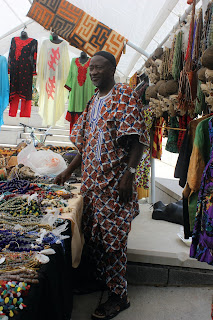Beat From the Street (September 17, 2014)
Many stories lurk throughout Asheville, whether they are behind the Vaudevillian jazz-folk played by buskers around Pritchard Park, the colorful businesses decorated with funky, hand-made crafts or the laughter echoing from a patio as locals and tourists alike enjoy delicious beer.
Nema Saho, originally from Gambia, purveyor of African tribal art and textiles
Nema Saho, originally from Gambia, purveyor of African tribal art and textiles
How do you describe your style?
“Well, traditional from all over Africa: Kente cloth from Ghana, Kuba cloth from Zaire and mud cloth from Mali.”
What made you initially want to start selling these?
“Oh, I’ve been doing this for over 40 years, back in Boston and New York.”
David Coon, Qigong Instructor, originally from Syracuse, New York
David Coon, Qigong Instructor, originally from Syracuse, New York
Tell me about yourself.
“I am a Qigong master and medical Qigong practitioner. Qigong is an ancient practice from China that is about 5,000 years old. Medical Qigong was developed about 2,500 years ago by Chinese physicians and it is a form of Chinese exercise which is like an energy practice.”
So tell me about your style. Why are you dressed this way?
First of all, this particular style represents completely who I am. The uniform is what I wear to work. So if I show up to work and go to teach it’s a traditional Chinese uniform.
“But for me, this particular style suits me, fits me. It’s flowy, it’s flashy, it’s a bright color of red so it stands out. It’s made of silk and it’s very high-quality material.
“When I walk into a room, or walk down the street or walk around the corner, right away you can see people’s heads come up. It catches you and it’s awakening. My whole mission as a person is to wake other people up. What they do with that – that’s their business.
As far as the shoes, if I were traditionally Chinese, I would have my little Chinese booties on. If I was maybe even a little more traditional, I might be walking in my bare feet.”
It’s a beautiful thing to connect to the Earth. But for me — just in terms of who I am — you can clearly see that I’ve probably run in these shoes a lot and like many of the monks, they run to clear their mind. Everyday, their training is to run up the mountain. Get above the city. Get above the heaviness of the world and somehow rise above it. Go sit on a mountaintop. Clear your mind.
So for me, these are my modern-day Chinese shoes, even if they’re flashy orange Adidas. If I have a lunch break when I work, I run up a mountain and eat later at night. It literally keeps me mobile and allows me to move freely — very relaxed and very free.
My shoes allow me to move freely but they also allow me to move quickly. So for me that’s sort of how I live my life – swiftly. If it needs to be, other moments – softly; consciously, casually, relaxed, but quick if I need to be.
Meditation is in movement. If you’re still, that’s meditation, but if you’re in movement, that’s also meditation. If I’m driving my car in the rain, that’s meditation. But sometimes you’re not moving— you’re still. Everything’s meditation.”
The original version of this article was published in The Blue Banner in 2014.
The original version of this article was published in The Blue Banner in 2014.




Comments